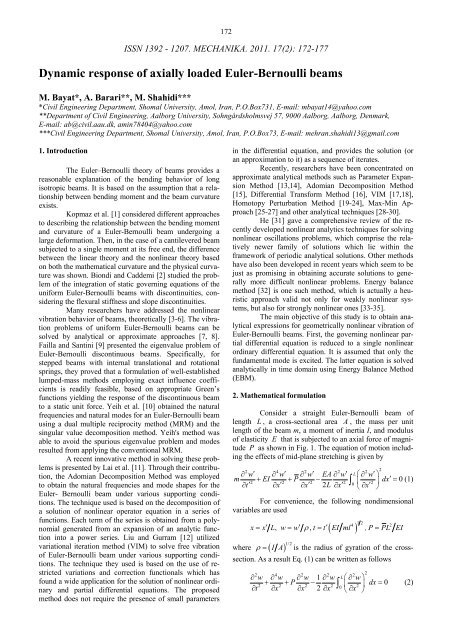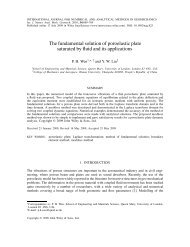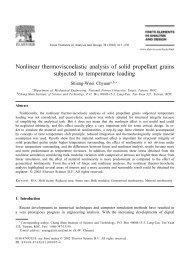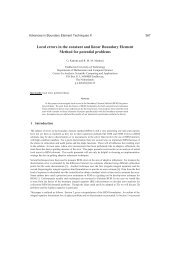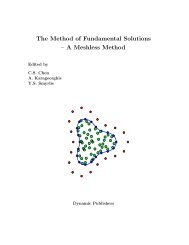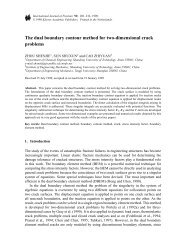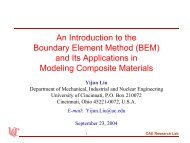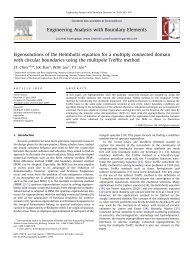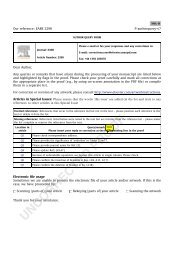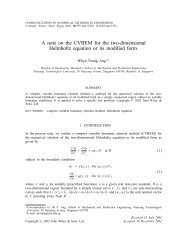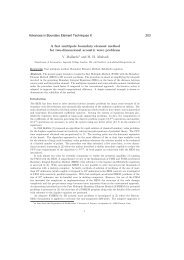Dynamic response of axially loaded Euler-Bernoulli beams
Dynamic response of axially loaded Euler-Bernoulli beams
Dynamic response of axially loaded Euler-Bernoulli beams
You also want an ePaper? Increase the reach of your titles
YUMPU automatically turns print PDFs into web optimized ePapers that Google loves.
172ISSN 1392 - 1207. MECHANIKA. 2011. 17(2): 172-177<strong>Dynamic</strong> <strong>response</strong> <strong>of</strong> <strong>axially</strong> <strong>loaded</strong> <strong>Euler</strong>-<strong>Bernoulli</strong> <strong>beams</strong>M. Bayat*, A. Barari**, M. Shahidi****Civil Engineering Department, Shomal University, Amol, Iran, P.O.Box731, E-mail: mbayat14@yahoo.com**Department <strong>of</strong> Civil Engineering, Aalborg University, Sohngårdsholmsvej 57, 9000 Aalborg, Aalborg, Denmark,E-mail: ab@civil.aau.dk, amin78404@yahoo.com***Civil Engineering Department, Shomal University, Amol, Iran, P.O.Box73, E-mail: mehran.shahidi13@gmail.com1. IntroductionThe <strong>Euler</strong>–<strong>Bernoulli</strong> theory <strong>of</strong> <strong>beams</strong> provides areasonable explanation <strong>of</strong> the bending behavior <strong>of</strong> longisotropic <strong>beams</strong>. It is based on the assumption that a relationshipbetween bending moment and the beam curvatureexists.Kopmaz et al. [1] considered different approachesto describing the relationship between the bending momentand curvature <strong>of</strong> a <strong>Euler</strong>-<strong>Bernoulli</strong> beam undergoing alarge deformation. Then, in the case <strong>of</strong> a cantilevered <strong>beams</strong>ubjected to a single moment at its free end, the differencebetween the linear theory and the nonlinear theory basedon both the mathematical curvature and the physical curvaturewas shown. Biondi and Caddemi [2] studied the problem<strong>of</strong> the integration <strong>of</strong> static governing equations <strong>of</strong> theuniform <strong>Euler</strong>-<strong>Bernoulli</strong> <strong>beams</strong> with discontinuities, consideringthe flexural stiffness and slope discontinuities.Many researchers have addressed the nonlinearvibration behavior <strong>of</strong> <strong>beams</strong>, theoretically [3-6]. The vibrationproblems <strong>of</strong> uniform <strong>Euler</strong>-<strong>Bernoulli</strong> <strong>beams</strong> can besolved by analytical or approximate approaches [7, 8].Failla and Santini [9] presented the eigenvalue problem <strong>of</strong><strong>Euler</strong>-<strong>Bernoulli</strong> discontinuous <strong>beams</strong>. Specifically, forstepped <strong>beams</strong> with internal translational and rotationalsprings, they proved that a formulation <strong>of</strong> well-establishedlumped-mass methods employing exact influence coefficientsis readily feasible, based on appropriate Green’sfunctions yielding the <strong>response</strong> <strong>of</strong> the discontinuous beamto a static unit force. Yeih et al. [10] obtained the naturalfrequencies and natural modes for an <strong>Euler</strong>-<strong>Bernoulli</strong> beamusing a dual multiple reciprocity method (MRM) and thesingular value decomposition method. Yeih's method wasable to avoid the spurious eigenvalue problem and modesresulted from applying the conventional MRM.A recent innovative method in solving these problemsis presented by Lai et al. [11]. Through their contribution,the Adomian Decomposition Method was employedto obtain the natural frequencies and mode shapes for the<strong>Euler</strong>- <strong>Bernoulli</strong> beam under various supporting conditions.The technique used is based on the decomposition <strong>of</strong>a solution <strong>of</strong> nonlinear operator equation in a series <strong>of</strong>functions. Each term <strong>of</strong> the series is obtained from a polynomialgenerated from an expansion <strong>of</strong> an analytic functioninto a power series. Liu and Gurram [12] utilizedvariational iteration method (VIM) to solve free vibration<strong>of</strong> <strong>Euler</strong>-<strong>Bernoulli</strong> beam under various supporting conditions.The technique they used is based on the use <strong>of</strong> restrictedvariations and correction functionals which hasfound a wide application for the solution <strong>of</strong> nonlinear ordinaryand partial differential equations. The proposedmethod does not require the presence <strong>of</strong> small parametersin the differential equation, and provides the solution (oran approximation to it) as a sequence <strong>of</strong> iterates.Recently, researchers have been concentrated onapproximate analytical methods such as Parameter ExpansionMethod [13,14], Adomian Decomposition Method[15], Differential Transform Method [16], VIM [17,18],Homotopy Perturbation Method [19-24], Max-Min Approach[25-27] and other analytical techniques [28-30].He [31] gave a comprehensive review <strong>of</strong> the recentlydeveloped nonlinear analytics techniques for solvingnonlinear oscillations problems, which comprise the relativelynewer family <strong>of</strong> solutions which lie within theframework <strong>of</strong> periodic analytical solutions. Other methodshave also been developed in recent years which seem to bejust as promising in obtaining accurate solutions to generallymore difficult nonlinear problems. Energy balancemethod [32] is one such method, which is actually a heuristicapproach valid not only for weakly nonlinear systems,but also for strongly nonlinear ones [33-35].The main objective <strong>of</strong> this study is to obtain analyticalexpressions for geometrically nonlinear vibration <strong>of</strong><strong>Euler</strong>-<strong>Bernoulli</strong> <strong>beams</strong>. First, the governing nonlinear partialdifferential equation is reduced to a single nonlinearordinary differential equation. It is assumed that only thefundamental mode is excited. The latter equation is solvedanalytically in time domain using Energy Balance Method(EBM).2. Mathematical formulationConsider a straight <strong>Euler</strong>-<strong>Bernoulli</strong> beam <strong>of</strong>length L , a cross-sectional area A , the mass per unitlength <strong>of</strong> the beam m, a moment <strong>of</strong> inertia I, and modulus<strong>of</strong> elasticity E that is subjected to an axial force <strong>of</strong> magnitudeP as shown in Fig. 1. The equation <strong>of</strong> motion includingthe effects <strong>of</strong> mid-plane stretching is given by2 4 2 2 2∂ w′ ∂ w′ ∂ w′ EA∂ w′ L ⎛∂w′⎞m + EI + P − dx 02 2 2 2 ⎜0 2 ⎟ ′∂t′ ∂x′ ∂x′ 2L∂x′ ∫ ⎝ ∂x′= ⎠(1)For convenience, the following nondimensionalvariables are used( ) 12= ′ = ′ = ′=4 2x x L, w w ρ , t t EI ml , P PL EIwhere ρ = ( I A) 1/2is the radius <strong>of</strong> gyration <strong>of</strong> the crosssection.As a result Eq. (1) can be written as follows2 4 2 2 2∂ w ∂ w ∂ w 1 ∂ w L⎛∂w⎞+ + P − d 02 2 2 2 ⎜0 2 ⎟ x =∂t ∂x ∂x 2 ∂x ∫ ⎝ ∂x(2)⎠22
173buckling load can be determined asP =− α α(8)c1 2 .3. Basic idea <strong>of</strong> energy balance methodFig. 1 A schematic <strong>of</strong> an <strong>Euler</strong>-<strong>Bernoulli</strong> beam subjectedto an axial loadAssuming wxt ( , ) = Wt ( ) φ ( x)where φ ( x)isthe first eigenmode <strong>of</strong> the beam [36] and applying the Galerkinmethod, the equation <strong>of</strong> motion is obtained as follows2dWt2()3+ ( α1 + Pα2) W() t + α3W () t = 0 (3)dtEq. (3) is the differential equation <strong>of</strong> motion governingthe nonlinear vibration <strong>of</strong> <strong>Euler</strong>-<strong>Bernoulli</strong> <strong>beams</strong>.The center <strong>of</strong> the beam is subjected to the following initialconditionsdW (0)W(0) = Wmax, = 0(4)dtwhere W maxdenotes the nondimensional maximum amplitude<strong>of</strong> oscillation.Under the transformation τ = ω t , the Eq. (3) canbe written asW 3+ + P W + W = 0 (5)2ω ( α1 α2)α3where ω is the nonlinear frequency and double-dot denotesdifferentiation with respect to τ and α1,α2and α3are as follows⎛⎜α =⎝∫101 1⎛⎜α =⎝∫4⎛∂φ( x)⎞ ⎞φ( x)dx4⎜ x ⎟ ⎟⎝ ∂ ⎠ ⎠2φ ( xdx )10∫02 12⎛∂φ( x)⎞ ⎞⎜ φ( x)dx2 ⎟ ⎟⎝ ∂x⎠ ⎠∫2φ ( xdx )00(6a)(6b)2 22⎛⎛ 1 ⎞⎛ 1 ∂ φ( x) 1 ⎛∂φ( x)⎞ ⎞ ⎞⎜⎜−⎟ dx φ( x)dx0 2 ⎜0 2 ⎟⎟⎜ 2∫ ⎜ ∂x∫⎝ ⎠ ⎝ ∂x⎠ ⎟ ⎟⎝α⎝⎠3=⎠1(6c)2φ ( xdx )∫Post-buckling load-deflection relation for theproblem can be obtained from Eq. (5) by substitutingω = 0 as2( α1 α3)P = − − W α2(7)Neglecting the contribution <strong>of</strong> W in Eq. (7), theIn the present paper, we consider a general nonlinearoscillator in the form [32]u′′ + f( u( t)) = 0(9)In which u and t are generalized dimensionlessdisplacement and time variables, respectively. Its variationalprinciple can be easily obtainedt ⎛ 1 2 ⎞J ( u) = ∫ − u′+ F( u)0⎜⎟⎝ 2 ⎠dt (10)2πwhere T = is period <strong>of</strong> the nonlinear oscillator,ωF ( u) = ∫ f ( u) du.formorIts Hamiltonian, therefore, can be written in the1= ′ + ( ) + ( )(11)22H u F u F A1 2R() t = − u′+ F( u) − F( A) = 0 (12)2Oscillatory systems contain two important physicalparameters, (i.e., the frequency ω and the amplitude <strong>of</strong>oscillation A ). So let us consider such initial conditionsu(0) = A, u′ (0) = 0(13)We use the following trial function to determinethe angular frequency ωut () = Acosωt(14)Substituting (14) into u term <strong>of</strong> (12), yield1 2 2 2Rt () = ω Asinω t+ F( Acosωt) − F( A) = 0 (15)2If, by chance, the exact solution had been chosenas the trial function, then it would be possible to make Rzero for all values <strong>of</strong> t by appropriate choice <strong>of</strong> ω . SinceEq. (14) is only an approximation to the exact solution,R cannot be made zero everywhere. Collocation atω t = π /4 gives2 F( A) − F( Acosωt)ω = (16)2 2AsinωtT =Its period can be written in the form2π2 F( A) − F( Acosωt)2 2Asinωt.(17)
1744. Application <strong>of</strong> the energy balance methodConsider the Eqs. (3) and (4) for the vibration <strong>of</strong>an <strong>Euler</strong>-<strong>Bernoulli</strong> beam. Free oscillation <strong>of</strong> the systemwithout damping is a periodic motion and under the transformationW() t = V( τ ), Eqs. (3) and (4) become as follows22 dV( τ )3ω + ( α2 1+ Pα2) V( τ) + α3V( τ) = 0 (18)dτdV (0)V(0) = Wmax, = 0(19)dτIts variational formulation can be readily obtainedas followsformandJ ( V)⎛ 1 dV ( τ ) 1 ⎞− ω + ( α + Pα) × ⎟ dτ⎟⎝⎠2=t⎜ 0 1 2∫ 2 dτ20 ⎜⎜× 2 4V ( τ) + α3V( τ)(20)Its Hamiltonian, therefore, can be written in the1 2 dV ( τ ) 1 20 (1 2 ) ()4H =− ω + α + Pα V τ + α3V() τ (21)2 dτ21 21 4Ht= 0= Wmax( α1+ Pα2)+ α4W max(22)2 41 2 dV ( τ ) 1 2Ht− Ht=0= ω0 + ( α1+Pα2) V ( τ) +2 dτ24 1 2 1 4+ α3V ( τ) − Wmax( α1 + Pα2)− α4Wmax2 4(23)According to Eq. (14) and Eq. (27), we can obtainthe following approximate solution⎛υ () t = Wmaxcos⎜⎝TEBM4( α + Pα ) + 3αW1 2 32ω02maxIts period can be written in the form=4πω4( α + Pα ) + 3αW01 2 35. Results and discussions2max⎞⎟⎠(28)(29)The simply supported and clamped <strong>beams</strong> areused to demonstrate the accuracy and effectiveness <strong>of</strong> theEnergy Balance Method, as the procedure explained inprevious sections. Table shows the comparison <strong>of</strong> nonlinearto linear frequency ratio ( ωNL ωL) with those reportedin the literature. It has illustrated that there is an excellentagreement between the results obtained from the energybalance method and those reported by Azrar et al. [37] andTableThe comparison <strong>of</strong> nonlinear to linear frequency ratioω ω )(NL LSimply supportedClampedW max Azrar[36]Qaisi[30]PresentstudyAzrar[36]Qaisi[30]Presentstudy1 1.0891 1.0897 1.0897 1.0221 1.0628 1.05722 1.3177 1.3229 1.3228 1.0856 1.2140 1.21253 1.6256 1.6394 1.6393 1.1831 1.3904 1.43444 - - 1.9999 1.3064 1.5635 1.6171We will use the trial function to determine the angularfrequencyω , i.e.V ( τ ) = Acosωτ(24)If we substitute Eq. (24) into Eq. (23), it resultsthe following residual equation1 2 2 1ω0( − Wmaxωsin( ωt)) + ( α1+Pα2 2)× 22 14× ( Wmaxcos( ωt)) + α3( Wmaxcos( ωt))−21 2 1 4− Wmax( α1+ Pα2) − α4Wmax= 02 4πIf we collocate at ω t = we obtain4(25)a1 2 2 2 1 2 3 4ω0Wmax ω − Wmax ( α1+ Pα2)− α3Wmax= 0 (26)4 4 16The nonlinear natural frequency and deflection <strong>of</strong>the beam centre become as followsω4( α + Pα ) + 3αW2NL=1 2 3 max2ω0(27)bFig. 2 Variation <strong>of</strong> the nondimensional amplitude ratioversus τ for Wmax= 1 and Wmax= 2
175Qaisi [30]. The difference between the nonlinear frequencyand linear frequency increases when the amplitude <strong>of</strong> vibrationis increased. In general, large vibration amplitudewill yield a higher frequency ratio. It can be easily seenthat for high-amplitude ratios the present method overestimatesthe frequencies <strong>of</strong> clamped <strong>beams</strong> but gives closeagreement with published results for simply supported<strong>beams</strong>. The reason is because <strong>of</strong> using the trigonometricbase functions in the application <strong>of</strong> energy balance method,which means that we assumed the general form <strong>of</strong> solutionis a combination <strong>of</strong> trigonometric functions. Since the eigenmodesfor simply supported <strong>beams</strong> involve only thesinusoidal component, the energy balance method givesmore accurate results in comparison with clamped <strong>beams</strong>which have hyperbolic component in their eigenmodes. Todemonstrate the accuracy <strong>of</strong> the obtained analytical resultswe also calculate the variation <strong>of</strong> nondimensional amplituderatio versus τ for the beam center using fourth-orderRunge-Kutta method. Fig. 2 illustrates the comparison betweenthese results. As can be seen in the figure, the resultsobtained using the energy balance method have a goodagreement with numerical results.6. ConclusionsIn this study, the energy balance method was employedto obtain analytical expressions for the nonlinearfundamental frequency and deflection <strong>of</strong> <strong>Euler</strong>-<strong>Bernoulli</strong><strong>beams</strong>. These expressions are valid for a wide range <strong>of</strong>vibration amplitudes, unlike the solutions obtained by theother analytical techniques such as perturbation methods.The energy balance method solution converges quickly andits components can be simply calculated. Also, comparedto other analytical methods, it can be observed that theresults <strong>of</strong> energy balance method require smaller computationaleffort and only a first-order approximation leads toaccurate solutions. Beside all the advantages <strong>of</strong> the energybalance method, there are no rigorous theories to direct usto choose the initial approximations, auxiliary linear operators,auxiliary functions, and auxiliary parameter. However,further research is needed to better understand theeffect <strong>of</strong> these parameters on the solution quality.References1. Kopmaz, O.; Gündogdu, Ö. 2003. On the curvature <strong>of</strong>an <strong>Euler</strong>–<strong>Bernoulli</strong> beam, International Journal <strong>of</strong> MechanicalEngineering Education, v.31, No.2: 132-142.2. Biondi, B.; Caddemi, S. 2005. Closed form solutions<strong>of</strong> <strong>Euler</strong>-<strong>Bernoulli</strong> <strong>beams</strong> with singularities, InternationalJournal <strong>of</strong> Solids and Structures, v.42, No9-10:3027-3044.3. Jalili, N.; Esmailzadeh, E. 2002. Adaptive-passivestructural vibration attenuation using distributed absorbers.Proceedings <strong>of</strong> the Institution <strong>of</strong> MechanicalEngineers, Part K: Journal <strong>of</strong> Multi-body <strong>Dynamic</strong>s,v.216, No3: 223-235.4. Sfahani, M.G.; Barari, A.; Omidvar, M.; Ganji,S.S.; Domairry, G. 2010. <strong>Dynamic</strong> <strong>response</strong> <strong>of</strong> inextensible<strong>beams</strong> by improved energy balance method.Proceedings <strong>of</strong> the Institution <strong>of</strong> Mechanical Engineers,Part K: Journal <strong>of</strong> Multi-body <strong>Dynamic</strong>s, in press, DOI:10.1177/2041306810392113.5. Tumonis, L.; Schneider, M.; Kačianauskas, R.;Kačeniauskas, A. 2009. Comparison <strong>of</strong> dynamic behaviour<strong>of</strong> EMA-3 railgun under differently inducedloadings, Mechanika 4(78): 31-37.6. Mazeika, D.; Bansevicius, R. 2009. Study <strong>of</strong> resonantvibrations shapes <strong>of</strong> the beam type piezoelectric actuatorwith pre<strong>loaded</strong> mass, Mechanika 2(76): 33-37.7. Meirovitch, L. 2001. Fundamentals <strong>of</strong> Vibrations. InternationalEdition. McGraw-Hill. 806p.8. Dimarogonas, A. 1996. Vibration for Engineers. 2nded. Prentice-Hall, Inc. 815p.9. Failla, G.; Santini, A. 2008. A solution method for<strong>Euler</strong>-<strong>Bernoulli</strong> vibrating discontinuous <strong>beams</strong>, MechanicsResearch Communications, v.35, No.8: 517-529.10. Yeih, W.; Chen, J.T.; Chang, C.M. 1999. Applications<strong>of</strong> dual MRM for determining the natural frequenciesand natural modes <strong>of</strong> an <strong>Euler</strong>-<strong>Bernoulli</strong> beamusing the singular value decomposition method, EngineeringAnalysis with Boundary Elements, v.23, No.4:339-360.11. Lai, H.Y.; Hsu, J.C.; Chen, C.K. 2008. An innovativeeigenvalue problem solver for free vibration <strong>of</strong> <strong>Euler</strong>_<strong>Bernoulli</strong>beam by using the Adomian decompositionmethod, Computers and Mathematics with Applications,v.56, No.12: 3204-3220.12. Liu, Y.; Gurram, C.S. 2009. The use <strong>of</strong> He's variationaliteration method for obtaining the free vibration<strong>of</strong> an <strong>Euler</strong>_<strong>Bernoulli</strong> beam, Mathematical and ComputerModelling, v.50, No.11-12: 1545 -1552.13. Wang, S.Q.; He, J.H. 2008. Nonlinear oscillator withdiscontinuity by parameter-expansion method, ChaosSolitons and Fractals, v.35, No.4: 688-691.14. Shou, D.H.; He, J.H. 2007. Application <strong>of</strong> parameterexpandingmethod to strongly nonlinear oscillators, InternationalJournal <strong>of</strong> Nonlinear Sciences and NumericalSimulation, v.8, No.1: 121-124.15. Mirgolbabaei, H.; Barari, A.; Ibsen, L.B.; Sfahani,M.G. 2010. Numerical solution <strong>of</strong> boundary layer flowand convection heat transfer over a flat plate, Archives<strong>of</strong> Civil and Mechanical Engineering, v.10, No.2: 41-51.16. Ganji, S.S.; Barari, A.; Ibsen, L.B.; Domairry, G.2010. Differential transform method for mathematicalmodeling <strong>of</strong> jamming transition problem in traffic congestionflow, Central European Journal <strong>of</strong> OperationsResearch, in press, DOI: 10.1007/s10100-010-0154-7.17. Barari, A.; Omidvar, M.; Ganji, D.D.; Tahmasebipoor, A. 2008. An approximate solution for boundaryvalue problems in structural engineering and fluid mechanics,Journal <strong>of</strong> Mathematical Problems in Engineering,Article ID 394103: 1-13.18. Fouladi, F.; Hosseinzadeh, E.; Barari, A.; DomairryG. 2010. Highly nonlinear temperature dependent finanalysis by variational iteration method, Journal <strong>of</strong>Heat Transfer Research, v.41, No.2: 155-165.19. Barari, A.; Omidvar, M.; Ghotbi, Abdoul, R.;Ganji, D.D. 2008. Application <strong>of</strong> homotopy perturbationmethod and variational iteration method to nonlinearoscillator differential equations, Acta ApplicandaMathematicae, v.104: 161-171.20. Omidvar, M.; Barari, A.; Momeni, M.; Ganji, D.D.2010. New class <strong>of</strong> solutions for water infiltration problemsin unsaturated soils, Geomechanics and Geoengineering:An International Journal, v.5, No.2: 127-135.
17621. Bayat, M.; Shahidi, M.; Barari A.; Domairry, G.2010. The approximate analysis <strong>of</strong> nonlinear behavior<strong>of</strong> structure under harmonic loading, InternationalJournal <strong>of</strong> the Physical Sciences, v.5, No.7: 1074-1080.22. Miansari, M.O.; Miansari, M.E.; Barari, A.; Domairry,G. 2010. Analysis <strong>of</strong> Blasius equation for flatplateflow with infinite boundary value, InternationalJournal for Computational Methods in EngineeringScience and Mechanics, v.11, No.2: 79-84.23. Ghotbi, Abdoul R.; Barari, A.; Ganji, D.D. 2008.Solving ratio-dependent predator–prey system withconstant effort harvesting using homotopy perturbationmethod, Journal <strong>of</strong> Mathematical Problems in Engineering,Article ID 945420: 1-8.24. Ganji, S.S.; Barari, A.; Domairry, G.; TeimourzadehBaboli, P. 2010. Consideration <strong>of</strong> transientstream/aquifer interaction with the non-linear Boussinesqequation using HPM, Journal <strong>of</strong> King Saud University,Science, in press, DOI:10.1016/j.jksus.2010.07.011.25. Ibsen, L.B.; Barari, A.; Kimiaeifar, A. 2010. Analysis<strong>of</strong> highly nonlinear oscillation systems using He’smax-min method and comparison with homotopy analysisand energy balance methods, Sadhana, v.35, No.4:1-16.26. Babazadeh, H.; Domairry, G.; Barari, A.; Azami, R.and Davodi, A.G. 2010. Numerical analysis <strong>of</strong> stronglynonlinear oscillation systems using He’s max-minmethod, Frontiers <strong>of</strong> Mechanical Engineering in China,DOI 10.1007/s11465-009-0033-x.27. Sfahani, M.G.; Ganji, S.S.; Barari, A.; Mirgolbabaei,H.; Domairry, G. 2010. Analytical solutions tononlinear conservative oscillator with fifth-order nonlinearity,Earthquake Engineering and Engineering Vibration,v.9, No.3: 1-9.28. Evensen, D.A. 1968. Nonlinear vibrations <strong>of</strong> <strong>beams</strong>with various boundary conditions, AIAA Journal, v.6,No.2: 370-372.29. Pillai, S.R.R.; Rao, B.N. 1992. On nonlinear free vibrations<strong>of</strong> simply supported uniform <strong>beams</strong>, Journal <strong>of</strong>Sound and Vibration, v.159, No.3: 527-531.30. Qaisi, M.I. 1993. Application <strong>of</strong> the harmonic balanceprinciple to the nonlinear free vibration <strong>of</strong> <strong>beams</strong>, AppliedAcoustics, v.40, No.2: 141-151.31. He, J.H. 2008. An elementary introduction to recentlydeveloped asymptotic methods and nanomechanics intextile engineering, International Journal <strong>of</strong> ModernPhysics B, v.22, No.10: 3487-3587.32. He, J.H. Preliminary report on the energy balance fornonlinear oscillations. -Mechanics Research Communications,2002, v.29, No.2-3, p.107-111.33. Bayat, M.; Shahidi, M.; Barari A.; Domairry, G.2011. Analytical Evaluation <strong>of</strong> the Nonlinear Vibration<strong>of</strong> Coupled Oscillator Systems, Zeitschrift für NaturforschungA, v.66a, No.1: 1-16.34. Ganji, S.S.; Ganji, D.D.; Ganji, Z.Z. 2009. Periodicsolution for strongly nonlinear vibration systems byHe's energy balance method, Acta ApplicandaeMathemathicae, v.106, No.1: 79-92.35. Momeni, M.; Jamshidi, N.; Barari, A.; Ganji, D.D.2010. Application <strong>of</strong> He’s energy balance method toDuffing harmonic oscillators. -International Journal <strong>of</strong>Computer Mathematics, in press,DOI:10.1080/00207160903337239.36. Tse, F.S.; Morse, I.E.; Hinkle, R.T. 1978. MechanicalVibrations: Theory and Applications. Second ed. Allynand Bacon Inc. Bosto. 449p.37. Azrar, L.; Benamar, R.; White, R.G. 1999. A semianalyticalapproach to the nonlinear dynamic <strong>response</strong>problem <strong>of</strong> S–S and C–C <strong>beams</strong> at large vibration amplitudespart I: general theory and application to thesingle mode approach to free and forced vibration analysis,Journal <strong>of</strong> Sound and Vibration, v.224: 183-207.M. Bayat, A. Barari, M. ShahidiAŠINE KRYPTIMI APKRAUTŲ EULERIO IRBERNULIO SIJŲ DINAMINIS ATSPARUMASR e z i u m ėNagrinėjamas naujo analitinio metodo, vadinamoenergijos balanso metodu (EBM), taikymas netiesiniamsuždaviniams spręsti. Energijos balanso metodas taikomasnetiesinių svyravimų poveikio <strong>Euler</strong>io ir Bernulio sijoms,apkrautoms ašiniais krūviais, analitiniam sprendimui gauti.Pasiūlytos sijų geometriškai netiesinių virpesių analitinėsišraiškos. Aptarta virpesių amplitudės įtaka netiesiniamdažniui. Energijos balanso metodo rezultatų palyginimassu literatūros rezultatais patvirtina šio metodo tikslumą.Šiuo metodu, priešingai nei įprastiniais metodais, tik vienupriartėjimu gaunamas labai tikslus sprendinys, galiojantisplačiame svyravimo amplitudžių intervale.M. Bayat, A. Barari, M. ShahidiDYNAMIC RESPONSE OF AXIALLY LOADEDEULER-BERNOULLI BEAMSS u m m a r yThe current research deals with application <strong>of</strong> anew analytical technique called Energy Balance Method(EBM) for a nonlinear problem. Energy Balance Method isused to obtain the analytical solution for nonlinear vibrationbehavior <strong>of</strong> <strong>Euler</strong>-<strong>Bernoulli</strong> <strong>beams</strong> subjected to axialloads. Analytical expressions for geometrically nonlinearvibration <strong>of</strong> <strong>beams</strong> are provided. The effect <strong>of</strong> vibrationamplitude on the nonlinear frequency is discussed. Comparisonbetween Energy Balance Method results and thoseavailable in literature demonstrates the accuracy <strong>of</strong> thismethod. In Energy Balance Method contrary to the conventionalmethods, only one iteration leads to high accuracy<strong>of</strong> the solutions which are valid for a wide range <strong>of</strong>vibration amplitudes.
177М. Баиат, А. Барари, М. СхахидиДИНАМИЧЕСКОЕ СОПРОТИВЛЕНИЕ БАЛОКЭУЛЛЕРА-БЕРНУЛИ НАГРУЖЕННЫХ ОСЕВОЙНАГРУЗКОЙР е з ю м еНастоящее исследование рассматривает применениенового аналитического метода, называемогометодом баланса энергии (МБЭ) для решения нелинейныхпроблем. Метод баланса энергии применяетсядля аналитического решения влияния нелинейных колебанийбалок Эуллера-Бернули, нагруженных осевойнагрузкой. Составлены аналитические зависимости длягеометрически нелинейных колебаний балок. Рассмотреновлияние амплитуды колебаний на нелинейнуючастоту. Сопоставление результатов метода балансаэнергии с результатами литературы подтверждает точностьэтого метода. Этот метод в противоположностьизвестным методам, уже после одного приближениядает точные результаты для широкого интервала амплитудколебаний.Received August 30, 2010Accepted April 11, 2011


